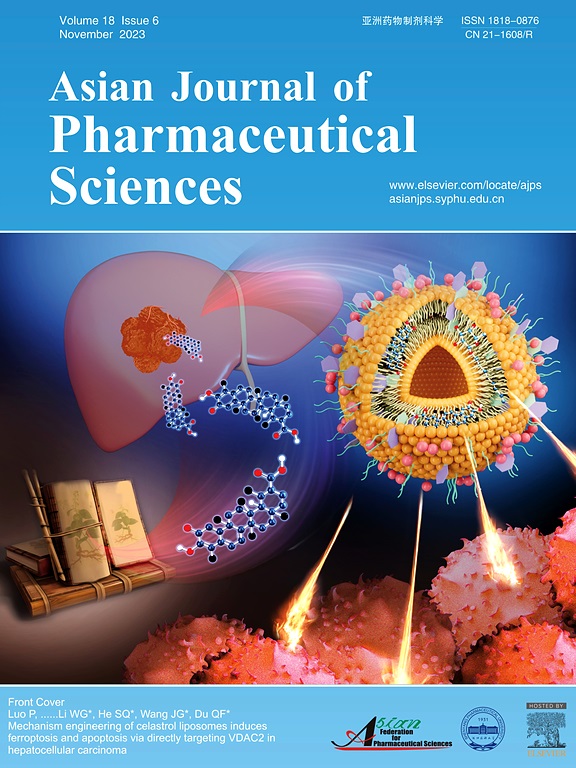通过在脂质纳米颗粒中共包封庆大霉素以实现高效siRNA递送和癌症治疗的内体破坏
IF 10.7
1区 医学
Q1 PHARMACOLOGY & PHARMACY
引用次数: 0
摘要
高效的siRNA递送对于疾病治疗是非常理想的。然而,传统纳米颗粒的应用受到无法从内溶酶体中逃逸的限制。在此,我们报告了一种使用小分子药物来增强siRNA内溶酶体释放的策略,以解决这一挑战。我们将庆大霉素(GM)封装到已上市的Onpattro®制剂中,建立LNP-siRNA/GM纳米颗粒,通过内体破坏促进siRNA内溶酶体逃逸,在机制上表现出LNP-siRNA/GM的独特功能和协同效应,以改善癌症治疗。此外,转基因诱导的活性氧(ROS)和磷脂在内溶酶体中积累,以及脂质纳米颗粒(LNPs)的物理特性被保留。我们还发现,转基因引起内溶酶体肿胀,破坏内体膜,使siRNA释放,正如半乳糖凝集素3募集和吖啶橙释放所证实的那样。该方法通过提高siRNA内溶酶体逃逸效率,实现了约81%的mRNA-EGFR沉默,高于LNP-siEGFR(约56.23%)。同时,LNP-siEGFR/GM在HepG2细胞中表现出显著的生物活性,这是由于siEGFR和GM与VEGF、CXCL12下调、ROS和磷脂上调协同作用所致。此外,静脉注射LNP-siEGFR/GM后,荷瘤裸鼠的肿瘤生长明显受到抑制。EGFR-siRNA与GM联合使用还能显著抑制血管生成、抑制肿瘤细胞增殖、诱导肿瘤细胞凋亡。因此,这种GM和siRNA共递送系统将为siRNA内体逃逸提供一种有效的策略,显著改善各种基于LNPs的siRNA递送系统的敲低,并有效地增强癌症治疗。本文章由计算机程序翻译,如有差异,请以英文原文为准。

Endosomal disruption by co-encapsulating gentamicin in lipid nanoparticles for efficient siRNA delivery and cancer therapy
Efficient siRNA delivery is highly desirable for disease treatment. However, the application of conventional nanoparticles is limited by the inability to escape from endo-lysosomes. Herein, we report a strategy using small-molecule drugs to enhance siRNA endo‐lysosomal release,addressing this challenge. We encapsulated gentamicin(GM) into the marketed Onpattro® formulation to establish LNP-siRNA/GM nanoparticles that promote siRNA endo‐lysosomal escape through endosomal disruption, mechanistically exhibiting unique functionality and synergistic effects of LNP-siRNA/GM to improve cancer therapy. Besides, GM induced reactive oxygen species (ROS) and phospholipids accumulation in endo‐lysosomes, as well as the physical characteristics of lipid nanoparticles (LNPs) were preserved. We also revealed that GM causes endo‐lysosomal swelling and disrupts the endosomal membrane to enable siRNA release, as confirmed by Galectin 3 recruitment and acridine orange release. This approach achieved ∼81% mRNA-EGFR silencing, which is more than LNP-siEGFR (∼56.23%) by enhancing siRNA endo‐lysosomal escape efficiency. Meanwhile, LNP-siEGFR/GM exhibited significant biological activities in HepG2 cells, driven by the synergistic effects of siEGFR and GM with the VEGF and CXCL12 downregulation of, and ROS and phospholipids upregulation. Furthermore, tumor growth was notably suppressed after intravenous injection of LNP-siEGFR/GM in tumor-bearing nude mice. The combination of EGFR-siRNA and GM could also greatly inhibit angiogenesis, be antiproliferative, and induce tumor cells apoptosis. Therefore, this GM and siRNA co-delivery system would provide an efficient strategy for siRNA endosomal escape, significantly improving knockdown in various LNPs based siRNA delivery systems and efficiently enhancing cancer therapy.
求助全文
通过发布文献求助,成功后即可免费获取论文全文。
去求助
来源期刊

Asian Journal of Pharmaceutical Sciences
Pharmacology, Toxicology and Pharmaceutics-Pharmaceutical Science
CiteScore
18.30
自引率
2.90%
发文量
11
审稿时长
14 days
期刊介绍:
The Asian Journal of Pharmaceutical Sciences (AJPS) serves as the official journal of the Asian Federation for Pharmaceutical Sciences (AFPS). Recognized by the Science Citation Index Expanded (SCIE), AJPS offers a platform for the reporting of advancements, production methodologies, technologies, initiatives, and the practical application of scientific knowledge in the field of pharmaceutics. The journal covers a wide range of topics including but not limited to controlled drug release systems, drug targeting, physical pharmacy, pharmacodynamics, pharmacokinetics, pharmacogenomics, biopharmaceutics, drug and prodrug design, pharmaceutical analysis, drug stability, quality control, pharmaceutical engineering, and material sciences.
 求助内容:
求助内容: 应助结果提醒方式:
应助结果提醒方式:


